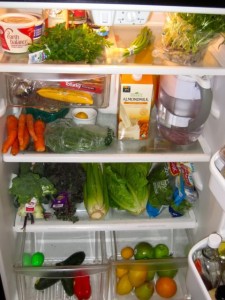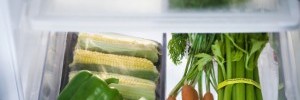How to store fresh vegetables
After vegetables are harvested, they are still viable and continue to respire by taking up oxygen and releasing carbon dioxide. This natural respiration contributes to the deterioration of their appearance, texture, flavor, and vitamin content. The faster a vegetable’s respiration, the more quickly it deteriorates. Post harvest respiration rates differ among vegetables, which contributes to why potatoes (yielding only about 8 ml of carbon dioxide per hour at 59°F/15°C) last longer than cabbage and green beans (yielding 32 and 250 ml of carbon dioxide per hour respectively).
Another factor contributing to produce spoilage is loss of moisture. Vegetables after being picked contain about 70 percent water, but it is then no longer replaced by its root or leaf system. Water loss, resulting in wilting and accelerated decomposition, can be avoided by maintaining a humid atmosphere, spraying with a fine mist, and/or covering the produce with an edible film or coating. Ultimately, the key to properly storing vegetables is to slow their respiration and moisture loss, allowing them to stay fresh longer.
 Refrigerated Storage
Refrigerated Storage
A cooler temperature is the most important factor in reducing respiration rates, and most fresh vegetables will last at least three days if refrigerated. Storage times for various vegetables are ultimately based on their water content. Vegetables with a high percentage of water, such as lettuce, tomatoes, and spinach, have shorter storage times than vegetables with less water content, such as potatoes, carrots, and turnips. Since leaves draw moisture from the rest of the plant, removing the green tops of carrots, radishes, or beets increases their length of storage.
Some vegetables require special storage treatment. Bean sprouts are best stored in a bowl of cold water in the refrigerator, and the water should be changed frequently. Ginger root should be frozen or stored in an airtight container to trap its moisture. It will keep up to a week at room temperature and for a month in the refrigerator. Mushrooms will keep up to five days if refrigerated in a paper bag or basket, but will deteriorate rapidly if exposed to moisture or warm air. Plastic bags are not recommended for mushrooms, which lack the protective skins of vegetables and fruits, contain 90 percent water, and emit a water vapor that collects inside a plastic bag even if it is vented with small holes. The increased humidity causes brown and black blotches on white mushrooms. Eggplants deteriorate quickly in either warm or cold temperatures, so they should be kept in a cool location (in an aerated plastic bag), where they will normally keep for about a day or two. Asparagus lasts longest if treated like flowers and refrigerated with their stem ends in a jar filled with about 1 inch of water.
An excellent way to retain moisture in vegetables is to store them in the refrigerator’s crisper, which is designed for that purpose. If a crisper is not available, plastic bags with tiny holes are a good choice because the holes allow the food to breath. Airtight plastic bags are not suitable for storing vegetables because they cause them to “stew,” thus promoting spoilage. Paper towels wrapped around moist vegetables can help to avoid the spoilage caused by dehydration. Fresh vegetables should not be frozen unless they are first blanched; their high water content causes undesirable texture changes when cell membranes burst upon freezing, and certain enzymes cause undesirable browning and deterioration. Cooked beans will last up to four or five days in the refrigerator, and up to six months in the freezer.
Dry Storage
Proper storage does not automatically imply refrigeration. Tomatoes (unripe), eggplant, winter squash, tubers (potatoes), dried legumes, and most bulbs (onions) should never be stored in a refrigerator. Tomatoes are picked green while still firm in order to handle the rigors of transportation; however, once at their destination, their ripening can be accelerated by placing them in a paper bag. Keeping them in a bag protects tomatoes from direct sunlight, which softens rather than ripens them. Tomatoes placed in the refrigerator will never reach their optimum flavor and texture. They should be stored in the refrigerator only when fully ripe, to slow spoilage.
Potatoes stored in the refrigerator undergo the conversion of their starch to glucose and develop an undesirable waxy consistency when cooked. French fries made from refrigerated potatoes turn an undesirable brown. Potatoes should not be exposed to sunlight, which will cause photosynthesis to take place, producing a bitter taste and, eventually, a potentially toxic compound called solanine, which can be seen as a slightly green tint on potato skins and sprouts. Eating large amounts of these green potatoes is not recommended because it may lead to poisoning. Potatoes will keep for a couple of weeks at room temperature stored in a basket or bag with holes, or longer in a cool root cellar (45° to 50°F/7° to 10°C). The exception is new potatoes, which are very perishable and should be used within a few days. Onions and potatoes should not be stored next to each other, because they shorten each others shelf life. Dried beans will keep up to a year stored in airtight containers in a dry place, but if kept too long and/or at high humidity (80 percent) and temperatures, dried beans will be hard to cook.
Controlled-Atmosphere Storage
Beyond simple refrigeration is a high-tech method of preservation called controlled-atmosphere storage, available to commercial food companies. This special method slows down the natural respiration of fresh vegetables by reducing the amount of oxygen (below 21 percent) and increasing the amount of carbon dioxide (above 0.03 percent) available to them while in storage. Such a contrived environment reduces a vegetable’s respiration and/or metabolic rate to such a degree that lettuce can last for up to 75 days.
